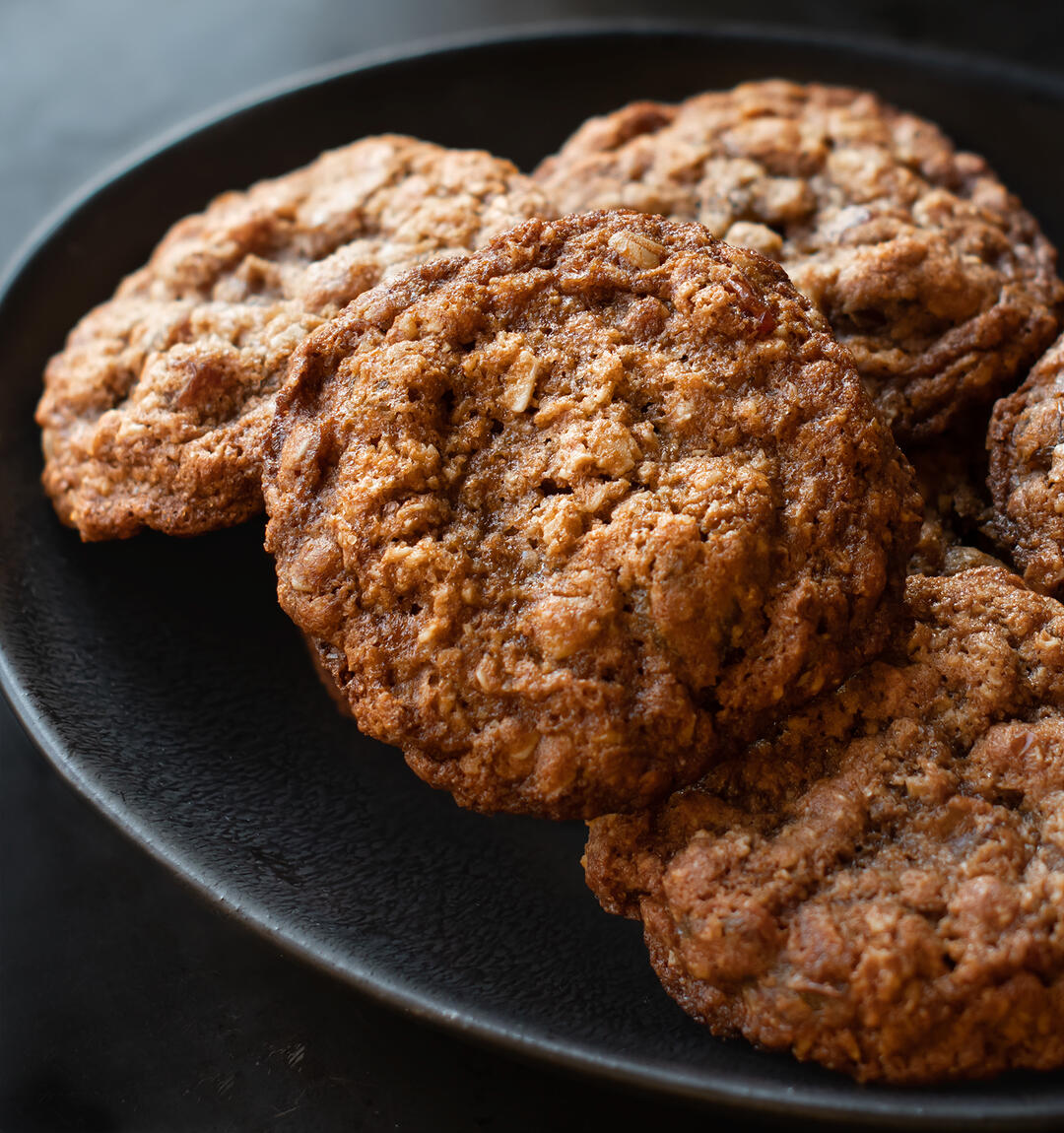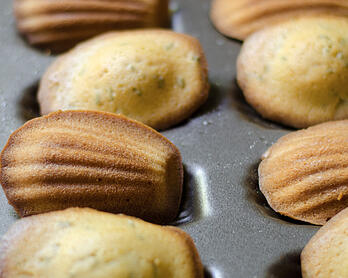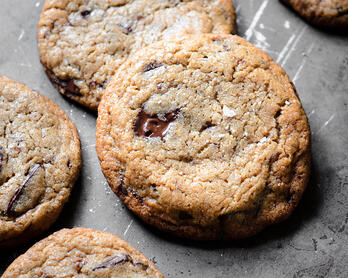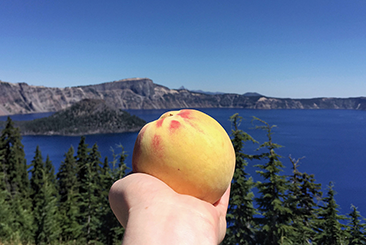Oatmeal Date Cookies
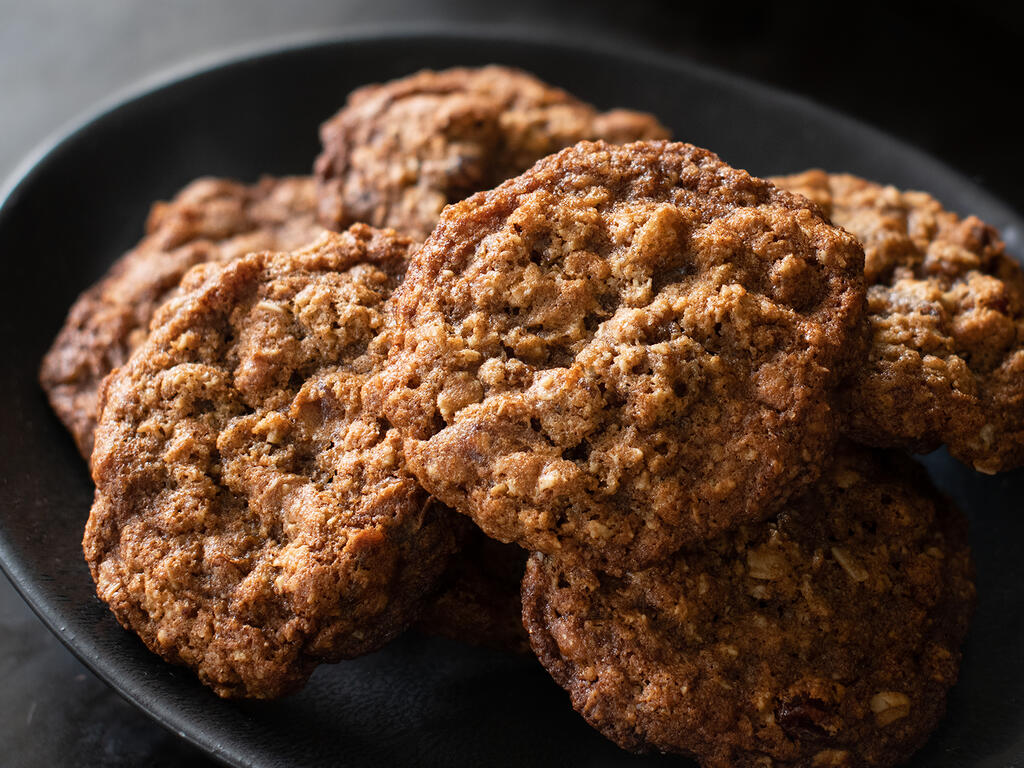
Oatmeal Date Cookies from Mother Grains made their first appearance on a recent Airstream trip. Maybe it was the altitude or that food tastes especially delicious after a hike, but the cookies were so well received that I ended up making a second batch at a different campsite. Driving snacks are an important matter and these delightful nuggets were qualified for the job.
Back in my non-wheeled kitchen, I experimented with inclusions that would compliment the sweet dates and amplify the nutty butterscotch notes. The gentle adaptation I settled on incorporates orange zest and a few subtle changes that otherwise leave the original cookie intact. Not only does the overall flavor sing, but the Mother Grains recipe is 100% whole grain which is sensible since there's not much reason for white flour in a dessert with a casual structure. Plus, sugar is much more satisfying when paired with whole grains.
Around the Dinner Table
Sweet, Delicious, and Marvelous
Before jumping into things, it's worth noting that the original version of this recipe does not have raisins and is very nice without them. While tinkering with the inclusions, I found that substituting raisins for a portion of the dates (cranberries and Zante currants would also work) added balance by cutting the sweetness. Dried grapes are a divisive subject so it felt important to clarify.
With that said, I find it interesting that the mention of raisins elicits such strong emotions from people. In one online thread about cookies, raisins were referred to as "the devil's mouse turds". That seems rather harsh. Raisins were apparently popular going back to ancient Egypt and serenaded the masses in the 1980s. Ray Charles, The Temptations - singing with or being a claymation California Raisin was the pinnacle. The California Raisins released four studio albums (really?) including "Sweet, Delicious, and Marvelous" and appeared in Emmy-nominated mockumentaries. Sales were up and they were living the dream. The ad campaign abruptly ended and, sadly, the California Raisins started doing drugs, landed in jail, and are now fructus non grata. Only the latter is true but it's still an unfortunate fall from beloved snack figurine to devil's mouse turds.
Slick marketing aside, food has to taste good. When fruit is bred to be productive, shelf stable, and able to withstand long hauls, flavor is often overlooked and variety is lost. You could call it the tomato effect (i.e. uniform lifeless orbs on grocery shelves) though they're valiantly climbing their way back. The monoculture story applies to many foods - apples, bananas, grapes - and it's not a good scene from a sustainability or enjoyment standpoint.
A 2001 L.A. Times article took issue with the sorry state of table grapes, and if you don't have dynamic grapes the raisins won't be much better.
Classic table varieties, with intense flavors, sensuous textures and distinctive identities, have vanished, leaving only crunchy, neutral-tasting seedless grapes, bred to be inoffensive to the greatest number of customers--nice for a sweet snack, but far from the flower of viticulture.
I remember years ago when it was pretty exciting to see flame grapes hit the farmers market tables. While still delicious, these days there are a dizzying number of varieties showing up during peak season. With a table grape renaissance comes the potential for excellent raisins. Just last week I walked by five different kinds courtesy of Peacock Family Farms and Murray Family Farms. I've tried Candy Snap, golden, IFG, and flame raisins with notes ranging from smoky fig to sweet molasses. I'm ready and waiting to cheer on a raisin comeback story.
Unladen Swallow
With so many raisins to choose from, I decided to swap some in for a portion of the cookie's dates. As I was admiring my dried fruit haul, it occurred to me that I didn't have the foggiest idea what the difference was between golden and flame. And you never know when random facts will come in handy.
Stick with me here, but there's an unrelated but related note to get out of the way before talking raisins. Real-deal black currants (blackcurrants if you're European) were illegal to grow in the United States beginning in the early 20th century and may still be illegal in a few states. There was some concern about the berry bushes carrying a fungus that affected pine trees. Even though modern breeding may be correcting for the fungus problem, black currants still don't have much traction in the United States.
I mention this because the use of the word "currant" in food marketing and writing needs to be tidied up. "Currants" should be paired with an identifying black, red, Zante, etc. Simply using the term "currants" is a recipe for confusion and a potential problem for a dish since black currants and Zante currants are not the same thing and have different flavor profiles.
On that note, Zante currants are not currants at all but rather they're raisins made from mini Corinth grapes. If folks reject raisins but are pro currant scone, they're pro (fancy) raisin and have been living a lie.
At some point we here in America started calling these mini raisins "currants" and added "Zante" because of a place of origin or misunderstood writing on a box (I didn't do much reading on that backstory.) Wikipedia had some clarity issues of its own suggesting that dried Cornith raisins are "simply currants" outside of the United States. On the contrary, black currants are currants and dried Corinth grapes are raisins or Zante currants. This is why the modifier is helpful in all cases. Maybe a geometry proof would be better at explaining this information. You can find more than a couple people griping online that they bought currants only to discover that what they had purchased were mini raisins.
So that covers Zante currants (aka dried mini Corinth grapes) and black currants but still hasn't touched upon the bulk of brown and golden-hued raisins which was my original question.
Raisin Mafia
The ubiquitous little red box with its bonneted maiden (who was a real person) means you're probably eating Thompson Seedless grapes. The variety is big business in the sunshine state with a historical landmark marking the original propagation site and, apparently, a raisin mafia. It's not surprising that there might be some friction among 750 growers who cooperatively (or not so cooperatively) own Sun-Maid. The shady dealings give new meaning to some of the quotes printed on the inside flap of the boxes. For example, is this inspirational or a threat?
"Fear is information; don't ignore it."
All of those California growers produce most of the raisins in the United States and 90+% of that output is the Thompson Seedless variety. This wasn't always the case though.
The seeded ‘Muscat of Alexandria’ was the first major raisin variety grown in California, but this was soon to change. Around 1872, William T. Thompson of Yuba City obtained grape cuttings from the Elwanger and Barry nursery of Rochester, New York, which described them as a grape from Constantinople called ‘Lady Decoverly.’ Local growers around Yuba City misnamed the variety ‘Thompson Seedless,’ an identification that has remained with the variety throughout its development and use in California. It was later identified as an Old World variety that originated in the Middle East, where it is known as ‘Sultanina’ or ‘Oval Kishmish.’ - L. Peter Christensen, U.C. Davis
Mr. Thompson was an Englishman identified as an "agricultural laborer" before immigrating to the United States. I searched around hoping to learn more about him but the only mentions seem to be his association with what is now a prolific grape variety bearing his name. Muscat raisins are sprinkled throughout older recipes for Christmas Pudding and Fruitcake but seem to have otherwise vanished from the scene based on my quick search.
The Sultanas of Swing
So most brown raisins are Thompson Seedless, then there's flame. It's a hybrid that was developed in the 1960s whose parents include Thompson Seedless, Cardinal, Malaga, and Muscat d'Alexandrie. Flame grapes produce delicious raisins that are a solid step up from the red box. I've bought them from Peacock Family Farms for years with family and friends asking for bags to be included in care packages.
Now there's the matter of raisins with a yellow hue. Much of the world calls them sultanas but the United States marketing machine calls them golden raisins. Kellogg's Raisin Bran is Sultana Bran in Australia and New Zealand so I guess our friends down under have gone their own way on that one. This goldfish is certainly excited about it.
But what exactly are golden raisins? Sultanas are made from light-colored grapes (usually but not always Thompson Seedless) that have been treated to retain the color. I found sites suggesting that the grapes were dipped in a caustic solution (sodium hydroxide, lye, or other) to speed up the drying process while other resources like Harold McGee suggested that golden raisins were just treated for color.
Golden raisins are made by treating the grapes with antioxidant sulfur dioxide and drying them mechanically at controlled temperatures and humidities; the result is a much fruitier, lighter flavor. - On Food And Cooking
In either case, golden raisins get some sort of treatment for color.
Some suggest that golden raisins are distinctly juicier and fruitier than brown but I couldn't help but wonder if the color was more of a marketing aesthetic. On a recent market visit, I asked one of my grape growers about it. She told me that golden raisins are treated with sulfur dioxide mainly to preserve the color. It adds a "bit of tang" but that's more a byproduct than an intention.
I stopped writing at this point and went into the kitchen to eat some raisins: Candy Snap, golden, and brown (variety flame). The Candy Snap raisins had an entirely different vibe with a dense texture and smoky fig newton notes so they were taken out of the game. Golden and brown flame were a better comparison so I recruited Rob to participate in my non-scientific experiment. We did some blind tastings to see which raisin we liked better and why. The conclusion was that the brown raisin had more depth while the golden raisins had a brighter flavor with a hint of pineapple but also a slight unfamiliar aftertaste which may have been the "tang" referred to above.
This brings things back around to the golden raisins aka sultanas that I added to the Oatmeal Date Cookies. Am I in dire straits for eating raisins given a treatment à la The Joker? Probably not, but brown raisins won our tasting contest so I'm inclined to use them in the future. That said, if a recipe risks being thrown off by the stronger flavor or color (or if I want to impress a goldfish), I'll go with sultanas.
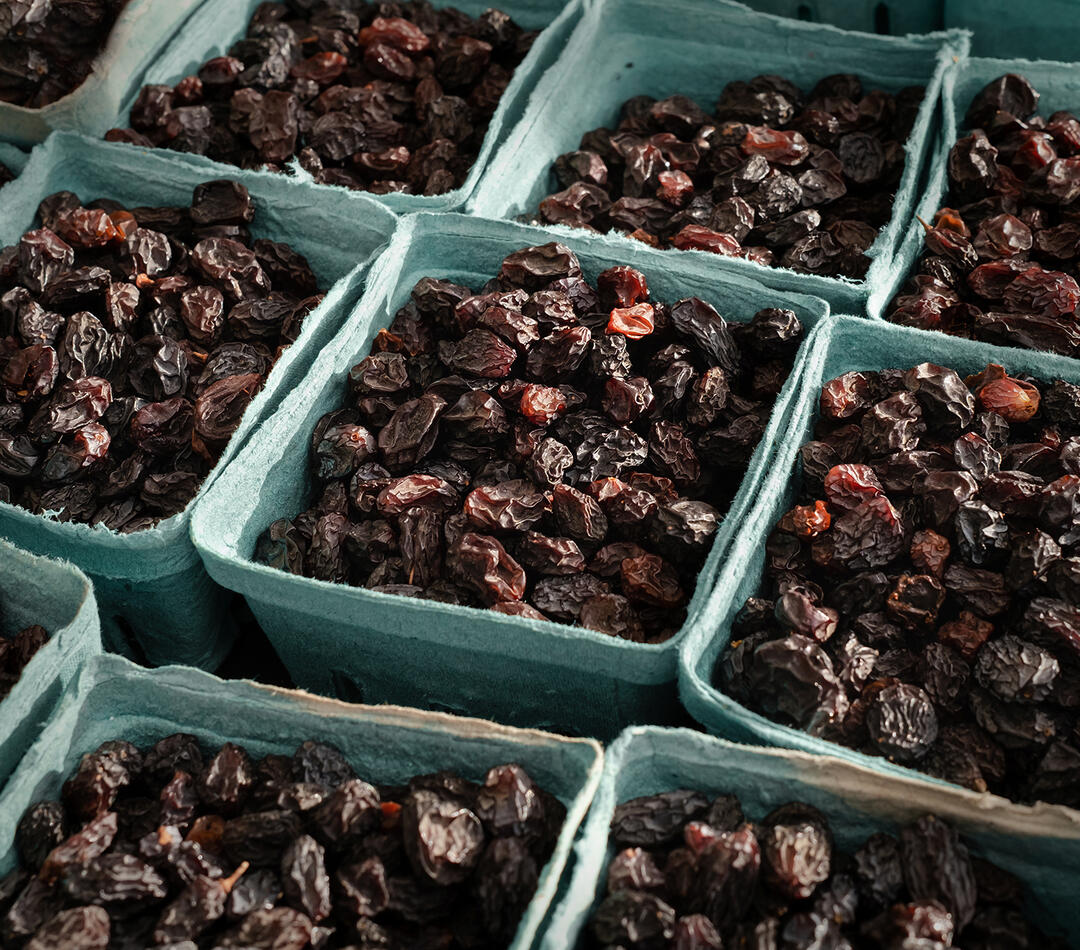 Raisins at Murray Family Farms - Santa Monica Farmers Market
Raisins at Murray Family Farms - Santa Monica Farmers Market
Original vs. Adapted
Orange Zest
This was the best adjustment I made to the cookies. My version includes 1/2 teaspoon (packed) zest which adds subtle notes of citrus. If you love orange (counting myself in that club) there's no harm in adding a bit more.
Save The Date
The cookbook version of these oatmeal cookies only uses dates and is pretty sweet. As already mentioned, I like the date cookies but found that substituting a portion of raisins balances things out a little.
Texture
I've seen some comments around the internet suggesting these cookies come out lacy and flat. I've baked them several times - with all dates and with a portion of raisins - and they always end up chewy with a slightly puffed top. The all-date version does spread more but it's not a lacy cookie so I'm not sure what to make of that feedback.
Sweet Stuff
The recipe calls for unsalted butter but I use salted butter for all of my cooking needs. If you prefer or only have unsalted, I recommend bumping up the Diamond kosher salt by a pinch. The idea is to pop the flavors not make the cookies perceptibly salty. Full disclosure is that I add a smidge more salt even when using salted butter but decided to leave that note out of the instructions. My concern was that would push the sodium too far for some people.
Baking Soda
I picked up a metallic aftertaste in the cookies so I cut the baking soda from 1 teaspoon to 3/4 teaspoon without issue.
Quantity
The original recipe divides the dough into 16 pieces that weigh 1 1/2 ounces (45 grams). I opt for 12 pieces that weight roughly 1 3/4 ounces (50 grams) each.
Recipe Tips
Not So Fast
I will echo the tip in Mother Grains that you don't want to use quick cooking oats in this cookie since they don't offer the right texture. Rolled oats are the way to go.
Are We There Yet
With chocolate chip cookies, I bake two off same day to satisfy my craving and then leave the dough in the refrigerator to hydrate for a day or so. More about that in the Sycamore Kitchen's Chocolate Chip Rye Cookie recipe. If instant gratification is what you seek, these oatmeal cookies are pretty excellent with only 1 to 1 1/2 hours of rest in the refrigerator. With that said, the flavors do marry up nicely when given a night in the refrigerator.
Chopped
I like the dates to be finely chopped - the softer dates (like Barhi) are basically mashed. It's a little sticky getting them into the dough but I find the overall texture is better. I also roughly chop the raisins to keep things consistent.
Alternative Inclusions
As already mentioned, I swapped in some raisins for a portion of the dates. Here are some additional ideas if you don't prefer raisins.
- Cranberries are best friends with oranges so that could be a nice ingredient to swap in for some of the dates.
- The Zuni Cafe scone recipe includes orange and Zante currants (dried Corinth grapes) and that combination is wonderful as is the book.
Farmers | Artisans
I make an effort to source my food from California artisans with a special focus on the Santa Monica Farmers Market. Below is a list of the folks who contributed to this dish.
- Polito Family Farms / Citrus
- Flying Disc Ranch / Dates
- Dates By Davall / Dates
- Grist & Toll / Whole Grain Sonora
- Camas Country Mill / Rolled Oats
- Murray Family Farms / Raisins
- Peacock Family Farms / Raisins
Oatmeal Date Cookies (Adapted From Mother Grains - 12 Cookies)
- 8 tablespoons (115 grams/4 ounces) salted butter, room temperature and cut into 24 cubes
- 1/2 packed teaspoon (2 grams) orange zest
- 50 grams (1 3/4 ounces) granulated sugar
- 100 grams (3 1/2 ounces) dark brown sugar
- 1/2 teaspoon Diamond kosher salt Note: See Recipe Tips regarding salt.
- 3/4 teaspoon baking soda
- 1/2 teaspoon ground cinnamon Note: I prefer Vietnamese.
- 1 large (50 grams out of shell) egg, room temperature
- 3/4 teaspoon vanilla
- 100 grams (3 1/2 ounces) Sonora or spelt whole grain flour
- 80 grams (2 3/4 ounces) old-fashioned rolled oats
- 95 grams (about 3 1/2 ounces) chopped pitted dates measured after prep Note: The original recipe calls for 145 grams of Medjool dates. I've made the 100% date version using a mix of honey and Barhi dates and it was very good. If you love dates go with that and just drop the next ingredient. The cookie will be sweeter and will spread more than what you see in the photos here.
- 50 grams (1 3/4 ounces) golden or flame raisins or dried fruit of choice, roughly chopped Note: A little bit of chopping keeps the overall texture consistent. And referring back to Around the Dinner Table, raisin objectors probably won't even know.
Instructions
Dough
- Set the egg and butter out before assembling the rest of the ingredients. They should be up to temperature by the time you're done with the mise en place. The butter should be softened but not greasy.
- Rub the sugars with the 1/2 teaspoon of orange zest then set aside. Sugar and zest has become one of my favorite smells.
- Sift together the salt, baking soda, and flour, dumping any bran flakes back into the pile. Add the cinnamon then whisk to combine.
- Using a paddle attachment (I have a KitchenAid Artisan), cream the butter and orange sugar on medium (Artisan setting 4) until well combined with a slightly lightened color, about 3 minutes.
- Scrape down the sides and bottom of the bowl then add the egg and vanilla. Mix on medium until combined, 30 to 45 seconds.
- Turn the mixer off and give a quick scrape. With the mixer off, add the flour mixture and oats then briefly mix on low. When the flour and oats are about 50% combined, turn the mixer off - the mixture will be very dry. Add half of the dates (and raisins/dried fruit of choice if using), give a few rotations on low, then turn the mixer off and add the rest of the fruit. Mix on low until the flour is just combined. The idea is to not overmix. Note: At this point, I like to use my fingertips to gently poke around the dough and break up any clumps of fruit before moving it to a piece of parchment.
- Transfer the lump of dough to a piece of parchment paper - it will be very sticky. Fold the parchment like a package, gently pressing the dough into a disc as you go. Place your cookie package in an airtight container and refrigerate for at least an hour. See Recipe Tips. Freeze any dough that isn't going to be used within a couple of days.
Bake
- Heat the oven to 350°F. Rack placement depends on how many cookies you're making. If you're baking the full dozen, place the racks in the upper and lower middle positions. If you're only making half (6 cookies), place the rack in the middle position. I've only ever made a half batch on the middle rack since I usually spread the baking out over a couple of days or freeze the leftover dough.
- Line a baking sheet with foil and then place a piece of parchment paper on top.
- When the oven is ready, take the dough out of the refrigerator and roll it into 50 gram (1 3/4 ounce) balls. Place them at least 3 inches apart. The cookies can spread (and the spread seems to vary between bakers) so definitely give them breathing room.
- Bake for 16 to 18 minutes until the edges are a deep caramel color. If using one pan, rotate halfway through the baking time. If using two pans, rotate the pans and switch the racks halfway through.
RV Adaptation
I don't have a KitchenAid on the Airstream and my Cuisinart multi-tool with the whisk attachment couldn't handle the creaming step with the butter and sugar. Here is the model with just the whisk. That's what I would buy if doing things again. I ended up mashing together the butter, sugar, egg, and vanilla with a fork to give the whisk a running start and then beat everything until somewhat fluffy. Then I went through the rest of the steps by hand using a rubber spatula and it worked out fine. I suppose you could use this method in a home kitchen but I think there's some texture science when it comes to not aerating the egg in the first step. An experiment for another day.
On the hand blender note, I went with a rechargeable version and that turned out to be a good call. It's nice not to have cords running across the small kitchen counter (plus there's only one outlet) and the blender is easy to use when cooking outdoors.
Newsletter
Subscribe at the bottom of this page for the Chic Eats roundup. It includes new and updated recipes along with a grab bag of content that was interesting enough to share around the dinner table.
